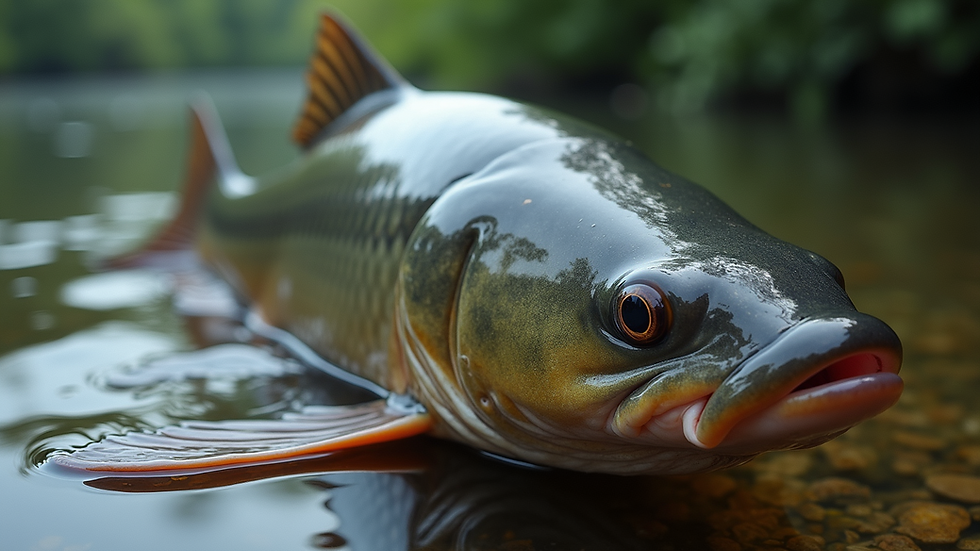Mastering the Challenge of Catfish: The Untold Secrets to Success
- Flying Fishman

- Jun 17
- 4 min read
Catching catfish can be both thrilling and challenging. For many anglers, it represents a true test of skill. Whether you are a novice or a seasoned expert, understanding the habits and habitats of these unique fish is key. What makes catfishing so difficult? Let’s unpack the secrets that can help you reel in more catfish during your next fishing trip.
Understanding Catfish Behavior
Catfish are intriguing creatures with complex behaviors and adaptations. They thrive in lakes, rivers, and ponds, often hovering near the bottom, relying on their sensitive barbels to find food in dark waters.
These fish are opportunistic feeders and will consume a wide variety of prey. Research indicates that catfish diets can include around 95 different species of fish and invertebrates depending on the season and location. Each season, particularly spring and summer, affects their feeding patterns dramatically.
During warmer months, catfish are more active at night, making nighttime fishing a productive strategy. Additionally, temperature changes can influence their behavior; for example, when water temperatures rise above 70°F, catfish may move to deeper, cooler waters.
The Right Gear for Catfishing
Choosing the right gear is essential for successful catfishing.
Rods and Reels
Rods: Opt for a sturdy fishing rod measuring between 6 to 9 feet. A medium to heavy action rod is crucial for handling the size and power of catfish.
Reels: Invest in a quality baitcasting or spinning reel designed to hold heavy line. Look for reels with high gear ratios; a 6:1 gear ratio allows for quick retrieval, which is beneficial when reeling in a large catch.
Line and Hooks
Using the appropriate line is vital. A braided fishing line ranging from 20 to 50-pound test is preferred, as it offers superior strength and sensitivity.
Hooks: Circle hooks are particularly effective for catfishing. These hooks tend to self-set when the fish takes the bait, enhancing your chances of a successful catch.
Bait Selection: The Catfish’s Favorite Treats
While catfish are not fussy eaters, some baits have consistently shown better results.
Natural Baits
Utilizing live or cut bait can lead to greater success in attracting catfish.
Live Bait: Small perch, shad, or minnows are excellent options. For instance, using a 4 to 6-inch shad can significantly increase your chances of attracting larger catfish.
Cut Bait: Freshly cut fish, such as 3 to 5-inch pieces of shad or herring, release oils in the water that catfish find irresistible.
Prepared Baits
Prepared baits, such as stink baits and dough balls, have also gained popularity among anglers. Surveys suggest that anglers using dough balls have caught up to 30% more catfish when targeting pond areas compared to those using only live bait.
Timing and Location: When and Where to Fish
Your success rate can greatly improve with careful timing and location selection.
Best Times to Fish
Catfish are most active during twilight hours—early morning and late evening. During these times, catfish often rise to the surface, making them easier to catch.
Ideal Locations
Identifying the right spots is crucial. Look for areas near submerged structures like logs and rocks, which provide cats shelter and hunting spots. Tidal zones, deeper holes, and channels have also shown a higher likelihood of yielding a solid catch.
Techniques for Successful Catfishing

Mastering specific techniques can elevate your fishing game significantly.
Still Fishing
This classic method is effective, especially during hot months. Set your line and allow the bait to sit undisturbed, as catfish prefer deeper waters to stay cool.
Drift Fishing
In this method, let your bait drift along natural currents. It enables you to cover more water and increases your chances of enticing nearby catfish.
Jug Fishing
This unconventional technique employs floating devices called jugs, designed to present your bait at various depths. Reports indicate that jug fishing can lead to a 20% higher catch rate for larger catfish compared to traditional methods.
Troubleshooting Common Challenges
Anglers often face challenges. Here are some common issues and practical solutions.
Low Activity Levels
If bites are scarce, it might be time to change your bait or relocate. For instance, if the water temperature suddenly drops, catfish may become less active.
Hooking Issues
Getting proper hookups can be tricky. Using circle hooks and allowing fish time to take the bait before setting the hook can improve your success.
Overcoming Weather Conditions
Rainy weather can reduce visibility; however, cloudy days can actually boost catfish activity. Cloud cover can lead to a 15% increase in catch rates as catfish feel more secure hunting.
Maintaining Respect for the Environment
Practicing responsible fishing ensures the sustainability of fish populations.
Catch and Release Techniques
If practicing catch and release, handle catfish with care using wet hands. Don’t keep them out of water for too long, and always properly measure and revive them to enhance their chances of survival.
Sustainable Fishing Practices
Be aware of local fishing regulations regarding size limits and seasonal restrictions. Adhering to these guidelines not only ensures continued fishing opportunities but helps protect catfish populations for generations to come.
Final Thoughts
Though catfishing can be challenging, equipping yourself with the right knowledge, techniques, and gear transforms the experience into something rewarding. Understanding catfish behavior, utilizing effective bait, and adapting to environmental factors are important strategies for success.
The path to mastering catfishing requires patience and ongoing practice, but the thrill of landing that memorable catfish makes it worthwhile. So, grab your gear, apply these secrets, and set out on your next catfishing adventure. Happy fishing!




